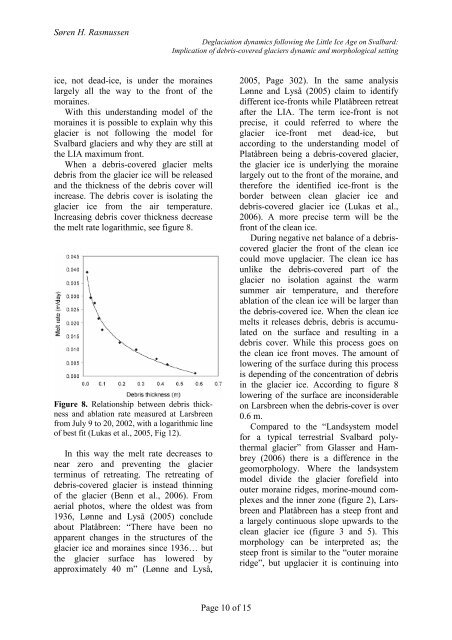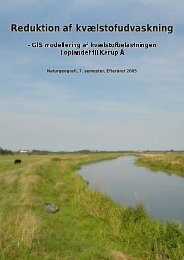Deglaciation dynamics following the Little Ice Age on Svalbard:
Deglaciation dynamics following the Little Ice Age on Svalbard:
Deglaciation dynamics following the Little Ice Age on Svalbard:
Create successful ePaper yourself
Turn your PDF publications into a flip-book with our unique Google optimized e-Paper software.
Søren H. Rasmussen<br />
ice, not dead-ice, is under <str<strong>on</strong>g>the</str<strong>on</strong>g> moraines<br />
largely all <str<strong>on</strong>g>the</str<strong>on</strong>g> way to <str<strong>on</strong>g>the</str<strong>on</strong>g> fr<strong>on</strong>t of <str<strong>on</strong>g>the</str<strong>on</strong>g><br />
moraines.<br />
With this understanding model of <str<strong>on</strong>g>the</str<strong>on</strong>g><br />
moraines it is possible to explain why this<br />
glacier is not <str<strong>on</strong>g>following</str<strong>on</strong>g> <str<strong>on</strong>g>the</str<strong>on</strong>g> model for<br />
<strong>Svalbard</strong> glaciers and why <str<strong>on</strong>g>the</str<strong>on</strong>g>y are still at<br />
<str<strong>on</strong>g>the</str<strong>on</strong>g> LIA maximum fr<strong>on</strong>t.<br />
When a debris-covered glacier melts<br />
debris from <str<strong>on</strong>g>the</str<strong>on</strong>g> glacier ice will be released<br />
and <str<strong>on</strong>g>the</str<strong>on</strong>g> thickness of <str<strong>on</strong>g>the</str<strong>on</strong>g> debris cover will<br />
increase. The debris cover is isolating <str<strong>on</strong>g>the</str<strong>on</strong>g><br />
glacier ice from <str<strong>on</strong>g>the</str<strong>on</strong>g> air temperature.<br />
Increasing debris cover thickness decrease<br />
<str<strong>on</strong>g>the</str<strong>on</strong>g> melt rate logarithmic, see figure 8.<br />
Figure 8. Relati<strong>on</strong>ship between debris thickness<br />
and ablati<strong>on</strong> rate measured at Larsbreen<br />
from July 9 to 20, 2002, with a logarithmic line<br />
of best fit (Lukas et al., 2005, Fig 12).<br />
In this way <str<strong>on</strong>g>the</str<strong>on</strong>g> melt rate decreases to<br />
near zero and preventing <str<strong>on</strong>g>the</str<strong>on</strong>g> glacier<br />
terminus of retreating. The retreating of<br />
debris-covered glacier is instead thinning<br />
of <str<strong>on</strong>g>the</str<strong>on</strong>g> glacier (Benn et al., 2006). From<br />
aerial photos, where <str<strong>on</strong>g>the</str<strong>on</strong>g> oldest was from<br />
1936, Lønne and Lyså (2005) c<strong>on</strong>clude<br />
about Platåbreen: “There have been no<br />
apparent changes in <str<strong>on</strong>g>the</str<strong>on</strong>g> structures of <str<strong>on</strong>g>the</str<strong>on</strong>g><br />
glacier ice and moraines since 1936… but<br />
<str<strong>on</strong>g>the</str<strong>on</strong>g> glacier surface has lowered by<br />
approximately 40 m” (Lønne and Lyså,<br />
<str<strong>on</strong>g>Deglaciati<strong>on</strong></str<strong>on</strong>g> <str<strong>on</strong>g>dynamics</str<strong>on</strong>g> <str<strong>on</strong>g>following</str<strong>on</strong>g> <str<strong>on</strong>g>the</str<strong>on</strong>g> <str<strong>on</strong>g>Little</str<strong>on</strong>g> <str<strong>on</strong>g>Ice</str<strong>on</strong>g> <str<strong>on</strong>g>Age</str<strong>on</strong>g> <strong>on</strong> <strong>Svalbard</strong>:<br />
Implicati<strong>on</strong> of debris-covered glaciers dynamic and morphological setting<br />
Page 10 of 15<br />
2005, Page 302). In <str<strong>on</strong>g>the</str<strong>on</strong>g> same analysis<br />
Lønne and Lyså (2005) claim to identify<br />
different ice-fr<strong>on</strong>ts while Platåbreen retreat<br />
after <str<strong>on</strong>g>the</str<strong>on</strong>g> LIA. The term ice-fr<strong>on</strong>t is not<br />
precise, it could referred to where <str<strong>on</strong>g>the</str<strong>on</strong>g><br />
glacier ice-fr<strong>on</strong>t met dead-ice, but<br />
according to <str<strong>on</strong>g>the</str<strong>on</strong>g> understanding model of<br />
Platåbreen being a debris-covered glacier,<br />
<str<strong>on</strong>g>the</str<strong>on</strong>g> glacier ice is underlying <str<strong>on</strong>g>the</str<strong>on</strong>g> moraine<br />
largely out to <str<strong>on</strong>g>the</str<strong>on</strong>g> fr<strong>on</strong>t of <str<strong>on</strong>g>the</str<strong>on</strong>g> moraine, and<br />
<str<strong>on</strong>g>the</str<strong>on</strong>g>refore <str<strong>on</strong>g>the</str<strong>on</strong>g> identified ice-fr<strong>on</strong>t is <str<strong>on</strong>g>the</str<strong>on</strong>g><br />
border between clean glacier ice and<br />
debris-covered glacier ice (Lukas et al.,<br />
2006). A more precise term will be <str<strong>on</strong>g>the</str<strong>on</strong>g><br />
fr<strong>on</strong>t of <str<strong>on</strong>g>the</str<strong>on</strong>g> clean ice.<br />
During negative net balance of a debriscovered<br />
glacier <str<strong>on</strong>g>the</str<strong>on</strong>g> fr<strong>on</strong>t of <str<strong>on</strong>g>the</str<strong>on</strong>g> clean ice<br />
could move upglacier. The clean ice has<br />
unlike <str<strong>on</strong>g>the</str<strong>on</strong>g> debris-covered part of <str<strong>on</strong>g>the</str<strong>on</strong>g><br />
glacier no isolati<strong>on</strong> against <str<strong>on</strong>g>the</str<strong>on</strong>g> warm<br />
summer air temperature, and <str<strong>on</strong>g>the</str<strong>on</strong>g>refore<br />
ablati<strong>on</strong> of <str<strong>on</strong>g>the</str<strong>on</strong>g> clean ice will be larger than<br />
<str<strong>on</strong>g>the</str<strong>on</strong>g> debris-covered ice. When <str<strong>on</strong>g>the</str<strong>on</strong>g> clean ice<br />
melts it releases debris, debris is accumulated<br />
<strong>on</strong> <str<strong>on</strong>g>the</str<strong>on</strong>g> surface and resulting in a<br />
debris cover. While this process goes <strong>on</strong><br />
<str<strong>on</strong>g>the</str<strong>on</strong>g> clean ice fr<strong>on</strong>t moves. The amount of<br />
lowering of <str<strong>on</strong>g>the</str<strong>on</strong>g> surface during this process<br />
is depending of <str<strong>on</strong>g>the</str<strong>on</strong>g> c<strong>on</strong>centrati<strong>on</strong> of debris<br />
in <str<strong>on</strong>g>the</str<strong>on</strong>g> glacier ice. According to figure 8<br />
lowering of <str<strong>on</strong>g>the</str<strong>on</strong>g> surface are inc<strong>on</strong>siderable<br />
<strong>on</strong> Larsbreen when <str<strong>on</strong>g>the</str<strong>on</strong>g> debris-cover is over<br />
0.6 m.<br />
Compared to <str<strong>on</strong>g>the</str<strong>on</strong>g> “Landsystem model<br />
for a typical terrestrial <strong>Svalbard</strong> poly<str<strong>on</strong>g>the</str<strong>on</strong>g>rmal<br />
glacier” from Glasser and Hambrey<br />
(2006) <str<strong>on</strong>g>the</str<strong>on</strong>g>re is a difference in <str<strong>on</strong>g>the</str<strong>on</strong>g><br />
geomorphology. Where <str<strong>on</strong>g>the</str<strong>on</strong>g> landsystem<br />
model divide <str<strong>on</strong>g>the</str<strong>on</strong>g> glacier forefield into<br />
outer moraine ridges, morine-mound complexes<br />
and <str<strong>on</strong>g>the</str<strong>on</strong>g> inner z<strong>on</strong>e (figure 2), Larsbreen<br />
and Platåbreen has a steep fr<strong>on</strong>t and<br />
a largely c<strong>on</strong>tinuous slope upwards to <str<strong>on</strong>g>the</str<strong>on</strong>g><br />
clean glacier ice (figure 3 and 5). This<br />
morphology can be interpreted as; <str<strong>on</strong>g>the</str<strong>on</strong>g><br />
steep fr<strong>on</strong>t is similar to <str<strong>on</strong>g>the</str<strong>on</strong>g> “outer moraine<br />
ridge”, but upglacier it is c<strong>on</strong>tinuing into







